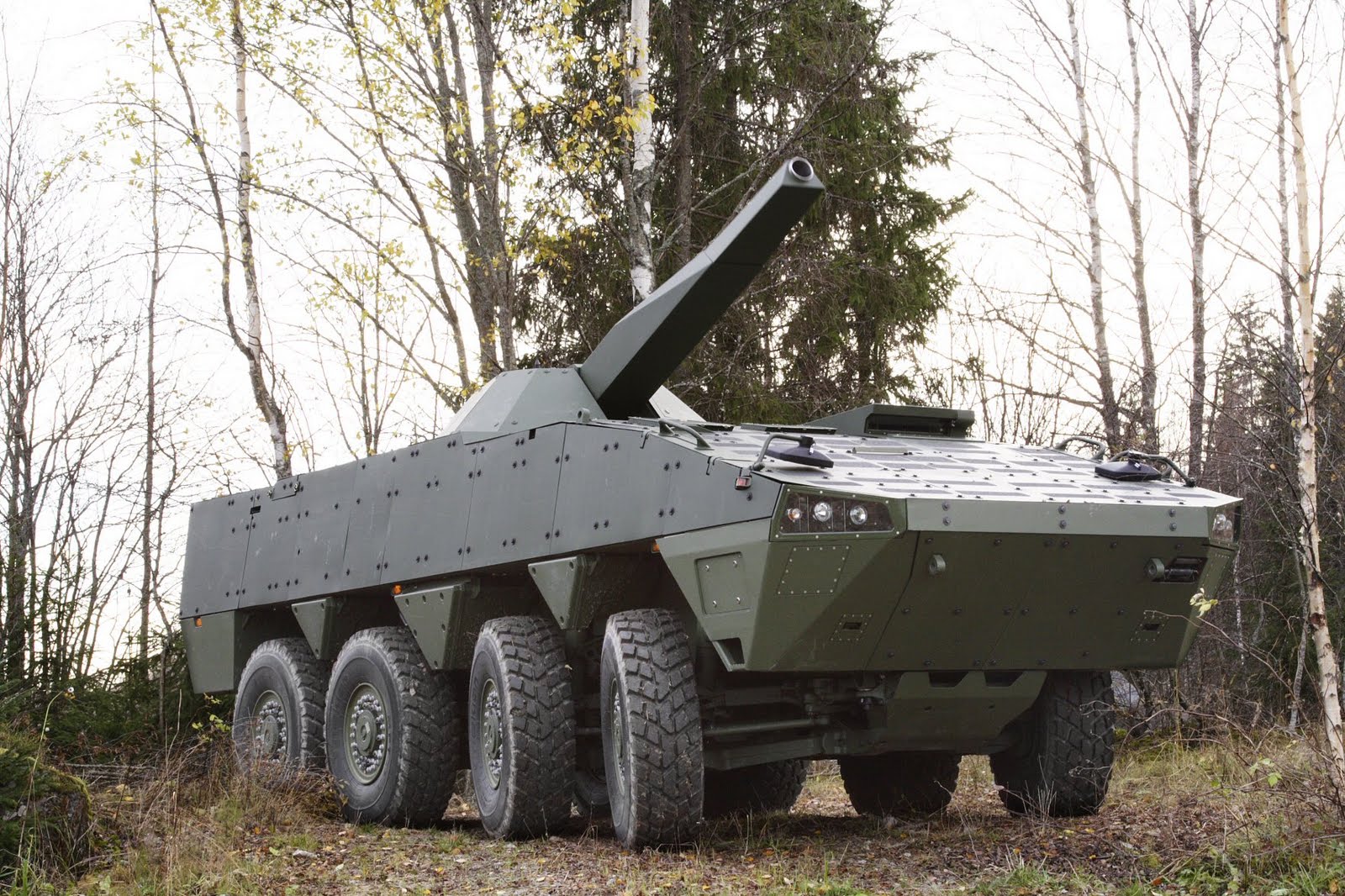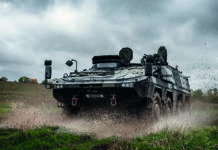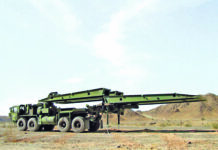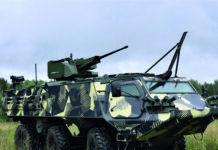Mortar systems continue to play a key role on the battlefield and are often referred
to as the infantry battalion commanders’ “pocket artillery”.
In the past, most mobile mortars were mounted in the rear of tracked and wheeled Armoured Personnel Carriers (APC), fired through the open roof hatches with manual traverse and elevation. Many users are now fitting the platform with an onboard Fire Control System (FCS) coupled to a Land Navigation System (LNS) to enable targets to be engaged more rapidly and with greater accuracy. Other developments, especially for larger calibre 120 mm mortars, include power traverse and elevation and a load assist device. Additionally, modern 4×4 vehicles can be equipped with mortar systems, including turret-mounted mortars.
Vehicle-Mounted Mortars
China is known to deploy a modified China North Industries Corporation (NORINCO) WMZ551 (6×6) APC, designated as the SM4, armed with a turntable-mounted 120 mm mortar coupled to a computerised FCS. The mortar can fire up to 30 x 120 mm mortar bombs with a maximum range of 7,500 m, which can be increased to 13,000 m by using a rocket-assisted projectile (RAP).
Thales of France (previously TDA) developed their 120 mm rifled 2R 2M turntable mortar system as a private venture. The 120 mm mortar is coupled to an FCS, has an automatic laying system, load assist device and has the same ballistics as the 120 mm MO-120-RT towed mortar system deployed by the French Army. Known export sales of the 120 mm 2R 2M include:
- Italy (FRECCIA 8×8)
- Oman (modified VAB)
- Saudi Arabia (upgraded M113A4 APC)
- Malaysia (ACV-19)
To supplement their deployed 120 mm MO-120-RT towed mortars, the French Army is installing the 120 mm 2R 2M in 54 of their new GRIFFON (6×6) APCs, with the complete system being called the Mortier Embarque Pour l’Appui au Contact (MEPAC). A guided 120 mm mortar bomb with a 15,000 m maximum range is currently being developed.
Israeli Mortars
Elbit Systems of Israel took over the complete range of products from Soltam and can now supply mortars and ammunition but also a range of FCS and forward observer systems. As well as marketing conventional towed mortars, they are also marketing their CARDOM 120 mm turntable-mounted mortars which are used by a number of countries including Israel (M113), Portugal (PANDUR III 8×8), and the US Army (STRYKER 8×8). The most recent customer is Denmark which has taken delivery of the CARDOM 10 integrated in their General Dynamics European Land Systems – MOWAG PIRANHA 5 (8×8) APC. Elbit have recently developed the 120 mm SPEAR which has been shown integrated on the rear of an AM General High Mobility Multi-Purpose Wheeled Vehicle (HMMWV).
Georgia has developed a turntable mounted mortar system called the GMM-120 armed with a 120 mm mortar with powered elevation and traverse and recoil reduction system. As an option, this can also be provided with a digital FCS and a GPS/INS navigation system.
To meet the requirements of the Singapore Armed Forces (SAF), STK Land Systems developed the 120 mm smoothbore Super Rapid Advanced Mortar System (SRAMS), which are integrated into the rear unit of the armoured BRONCO all-terrain tracked carrier (ATTC) and more recently a Paramount MRAP (4×4) platform used by the SAF. For trials, SRAMS has been installed on an STK Land Systems SPIDER light vehicle. Traverse and elevation is hydraulic and it is fitted with a Ring Laser Gyro (RLG), Automatic Fire-Control System (AFCS) and is laid onto the target using a flat panel display (FPD) and joystick. Further development resulted in the SRAMS Mk 2 with all electric traverse and elevation, with traverse increased to 180° left and right. This is being marketed with a new family of ammunition that includes an HE round with a maximum range of 9,000 m and the GPS PM120 Precision Guided (PG) mortar bomb.
The South Korean Army currently deploys the K242A1 107 mm (4.2 inch) and K281A1 81 mm SP mortars based on the Korean IFV with the mortar firing through open hatches. Under contract with the Defense Acquisition Program Administration (DAPA), Hanwha Defense has completed development of an SP 120 mm mortar system based on the KIFV platform. In the rear, a turntable-mounted 120 mm mortar developed by S&T Dynamics can be rapidly laid onto the target using the computerised FCS coupled to a LNS and features a load assist device.
The United Arab Emirates (UAE) deploys 72 AGRAB (SCORPION) Mk 2 mortar systems, with the International Golden Group as the prime contractor. STK Land Systems provides the 120 mm SRAMS, with Denel Land Systems suppling the RG31 (4×4) Mk 6E mine resistant ambush protected (MRAP) vehicle and Rheinmetall Denel Munitions of South Africa supplying the suite of 120 mm ammunition.
Hirtenberger Defence Europe are marketing the SRAMS Mk 2 together with their family of 120 mm mortar bombs in Europe. This combination was shown at DSEi in London in September 2019.
Further development of the first generation BIGHORN 120 mm mortar by RUAG Defence resulted in the 120 mm COBRA recoiling turntable-mounted mortar system which is all electric and has been installed in a (GDELS-MOWAG) PIRANHA 3+ (8×8) APC with first firing trials taking place in 2016. Oman was the first customer, with these systems integrated into the FNSS PARS (8×8) APC.
The Swiss Army has recently ordered 32 systems integrated into a PIRANHA (8×8) platform designated 12 cm Mortar 16. It has a computerised FCS and is laid onto the target using a joystick using the FPD on the left side and has a maximum range of up to 9,000 m.
Taiwan developed a Mobile Mortar System (MMS) that can be fitted with a turntable-mounted 81 mm or 120 mm barrel. A first application is installed in the locally developed CLOUD LEOPARD (8×8) APC firing through open roof hatches. The MMS is all electric and can be traversed through 360° with manual back-up and also features a FCS and load assist device.
Aselsan of Turkey possesses extensive experience in the development of turrets, gun control equipment and FCS and has now moved into the mortar market. The first of these is the ALKAR turntable mounted 120 mm which is already in service with the Turkish Gendarmarie mounted in the rear of a BMC VURAN (4×4) MRAP platform. It fires through the open roof hatches and has a load assist device. This system also has all electric traverse and elevation and is coupled to an Aselsan computerised FCS which uses shareable NATO Armaments Ballistic Kernel (NABK) fire control software with a maximum range of up to 8,000 m.
The company recently developed the ALKAR 81 mm smoothbore mortar,
using the ALKAR 120 mm mortar previously described but this can be installed on much lighter platforms such as the Toyota LAND CRUISER (4×4). The ALKAR 81 mm smoothbore mortar system includes an automatic barrel laying system, recoil system, computerised FCS and has powered traverse of 180° left and right. Aselsan are quoting a maximum range of 6,400 m.
In early 2019, MKEK unveiled their turntable mounted 120 mm smoothbore mortar system which has a traverse of 360 degrees. The operator is provided with an FPD laying the mortar onto the target using a joystick. It also features a load assist device and a recoil reduction system; MKEK are quoting a maximum range of up to 9,000 m. To meet the requirements of the Norwegian Army, Rheinmetall Norway developed a turntable-mounted 81 mm mortar system mounted on the Swedish BAE Systems Hagglunds CV90 MULTIC variant based on a refurbished CV90 Mk 1 hull.
A total of 16 CV90 MULTIC vehicles have been delivered, together with 16 kits for each of these allowing it to quickly re-roll according to mission requirements. The 16 kits comprise the 81 mm mortar, cargo carrier, VIP transport and casualty evacuation.
Further development by Rheinmetall Norway has resulted in the recently revealed MWS 120 RAGNAROK 120 mm turntable-mounted mortar system, currently fitted with a smoothbore barrel. This features all electic traverse and elevation and is fitted with a recoil system, computerised FCS and a GPS/INS navigation system. More recently, the MWS 81 has been installed in the rear mission module of a BOXER (8×8) MRAV and on the Turkish Nurol EJDER YALCIN (4×4) vehicle.
Thales South Africa Systems developed their integrated SCORPION Automated Mobile Mortar Platform as a private venture which has been installed on a number of platforms for trialling, including a Toyota LAND CRUISER (4×4) and the locally developed WASP (4×4) Rapid Deployment Reconnaissance Vehicle (RDRV) deployed by the South African Special Forces (SF). The pallet can be fitted with a turntable armed with a 60 mm, 81 mm or 82 mm mortar or even a rocket system, and fires over the rear arc of 250 degrees. A unique feature of the SCORPION is that it also has an onboard computerised FCS and navigation system with automatic laying of the mortar tube with a FPD in the cab; according to the manufacturer, “it fires from the back of a vehicle in less than 15 seconds.”
Turreted Mortars
NORINCO is marketing two 120 mm SPM systems designated the WMA029 (6×6) and the CS/SM2 (8×8). Both have a similar turret with the 120 mm ordnance and as well as an indirect fire capability, also possess a direct fire capability. The 120 mm ordnance is breech loaded with a stated maximum rate of fire of between 6 and 8 rounds a minute with a maximum range of up to 9,500 m. Within the People’s Liberation Army (PLA), the WMA029 is referred to as the PLL-05 while the CS/SM2 is deployed by Tanzania and marketed by Poly Technologies as the Type 07PA.
Russia has developed a complete range of SP mortars which they have always referred to as SP gun/mortars because of their direct fire capability. The first of these to enter service was the 120 mm 2S9 (NONA), which has seen action in Ukraine, based on a modified BMD Airborne Assault Vehicle (AAV) chassis and armed with a 120 mm rifled weapon. The maximum range in the indirect fire role is 8,855 m, but a RAP extends this to 13,000 m and it can also fire a High-Explosive Anti-Tank (HEAT) round for engaging threat AFVs. Some of these have been upgraded to the 2S9-1M standard with new FCS, INS and sensor suite.
The 2S9 was followed by the 2S23 based on a modified BTR-80 (8×8) and has a turret with similar capabilities with some units exported to Venezuela. The 2S31 VENA is based on a modified BMP-3 IFV chassis, developed to meet the requirements of the Russian Army, but is known to have been exported to both Azerbaijan and Venezuela. The 2S31 has a turret that can be traversed through 360° with the 120 mm 2A80 rifled weapon coupled to an onboard computerised FCS attached to a LNS and day/night sighting system. As well as firing the same suite of ammunition as the older 2S9 and 2S23, it can also fire a new generation of more effective ammunition with a maximum range of 18,000 m.
The Russian Army has also deployed the 2S34, which is essentially a 122 mm 2S1 tracked SP artillery system with the turret mounted 122 mm 2A31 howitzer removed and replaced by the complete 122 mm 2A80 ordnance of the 2S31 VENA. Russia has also recently revealed the 2S41 82 mm DROK mobile mortar based on the TAIFUN K-4386 (4×4) MRAP type and has a turret with direct and indirect fire capability. The TsNII Burevestnik, part of UralVagonZavod, is quoting a maximum range of up to 6,000 m.
The Russian 2S42 LOTOS is the replacement for the older 2S9 and is also armed with a turret mounted 120 mm rifled weapon based on a new amphibious chassis. Another Russian development is the 120 mm PHLOX designed by UralVagonZavod as a “self-propelled artillery system.” This is based on a 6×6 cross country chassis with the engine compartment at the front, protected four door cab in the middle and the 120 mm ordnance at the rear firing standard 120 mm mortar bombs.
Poland operates a large fleet of Finnish Patria 8×8 Armoured Modular Vehicle (AMV) manufactured under the local name of the ROSOMAK (WOLVERINE). Variants include one fitted with the locally developed HSW 120 mm RAK turret mounted mortar, called the M120. The breech loaded 120 mm mortar can carry out direct and indirect fire missions and in the latter role a maximum range of up to 10,000 m. It is fitted with a computerised FCS coupled day night sighting, INS + GPS and OBRA-3 SSP-1 laser warning system.
To meet the potential requirements of Finland and Sweden, the twin 120 mm Advanced Mortar System (AMOS) was developed by Patria (Finland) and the BAE Systems Hagglunds (Sweden), but Sweden pulled out of the programme. In the end, Finland took delivery of 18 AMOS systems and these are integrated onto the roof of a Patria AMV used by the Finnish Army as an APC.
Patria are now concentrating their marketing on their 120 mm smoothbore NEMO (New Mortar),developed as a private venture. Traverse is 360° and its automatic loading system gives a maximum rate of fire of 10 rounds/minute, sustained rate of fire of six rounds a minute and up to five rounds MRSI. The first customer for the 120 mm NEMO was the Saudi Arabian National Guard (SANG). A total of 36 have been installed on their General Dynamics Land Systems – Canada LAV (8×8) while the UAE has installed them on a coastal defence craft. NEMO has also been demonstrated in the US to meet a potential US Army requirement for a Future Indirect Fire Turret.
In December 2016, the Swedish Defence Material Administration (FMV) awarded BAE Systems Hagglunds a SEK575M (US$68M) for 40 twin 120 mm SP mortar systems called MJÖLNER (Thor’s Hammer) fitted onto stored 40 CV90 platforms which have now been delivered. In early 2022, another 20 were ordered for delivery by 2025. The turret is armed with twin 120 mm smoothbore muzzle loaded mortars fed by a mechanical handling system with four rounds able to be fired in about eight seconds. Maximum range firing unassisted 120 mm ammunition is 9,000 m and up to 56 x 120 mm mortar bombs are stowed in the bustle and up to 48 in the chassis. An INS is fitted and there is growth potential to add a computerised FCS.
Mobile 4×4 Mortars
A recent development concerns the Spanish EXPAL Integrated Mortar System, or EIMOS, which can be mounted on the rear of light platforms such as the Spanish URO VAMTAC (4×4). EIMOS was developed as a private venture and is armed with an 81 mm mortar fitted with an elastic recoil system based on hydro-pneumatic technology. Optionally, a 60 mm mortar can be installed instead. Maximum range depends on the calibre of the mortar fitted but EXPAL are quoting a maximum range of 6,200 m for the 81 mm version and 4,900 m for the 60 mm model. EIMOS uses GPS for position location but also has an INS and a meteorological station to increase accuracy. It is in service in the Middle East (Bahrain) in the 81 mm version installed on the rear of a VAMTAC ST5 (4×4) platform which also carries 52 x 81 mm mortar bombs.
The latest SP mortar system to be developed in Spain is the ALAKRAN 120 mm Light Mortar Carrier (LMC) developed using internal funding by New Technologies Global Systems (NTGS). This was only launched in 2016 but has already been deployed by least two countries, with Saudi Arabia taking delivery of 100 units and Ukraine receiving six. The Saudi system is integrated on the rear of a Toyota LAND CRUISER 70 (4×4) while those deployed by Ukraine are integrated into the rear of a locally developed BARS (4×4) APC.
When on the move, the 120 mm mortar is stowed in a horizontal position and when required for action, is lowered at the rear until the large baseplate touches the ground. This is powered by an electro-mechanical system which also lays the mortar onto the target using the onboard computerised FCS coupled to GPS and/or an INS. When fitted with a 120 mm smoothbore barrel, the maximum range is quoted as 8,250 m but this could be replaced by a 120 mm rifled barrel or even an 81 mm or 82 mm barrel.
In Paris in mid-2022, the system was shown integrated onto the rear of the Arquus SHERPA and called the A2M Advanced Mobile Mortar with the 120 mm rifled barrel provided by Thales.
Georgia has also developed and tested the DIDGORI MEOMARI 120 mm Mobile Mortar System which is integrated into the rear of their DIDGORI (4×4) light armoured vehicle. When travelling, the 120 mm mortar is stowed within the rear of the hull and when required is lowered to the ground complete with its baseplate and bipod. The 120 mm smoothbore mortar has a maximum range of 7,100 m.












